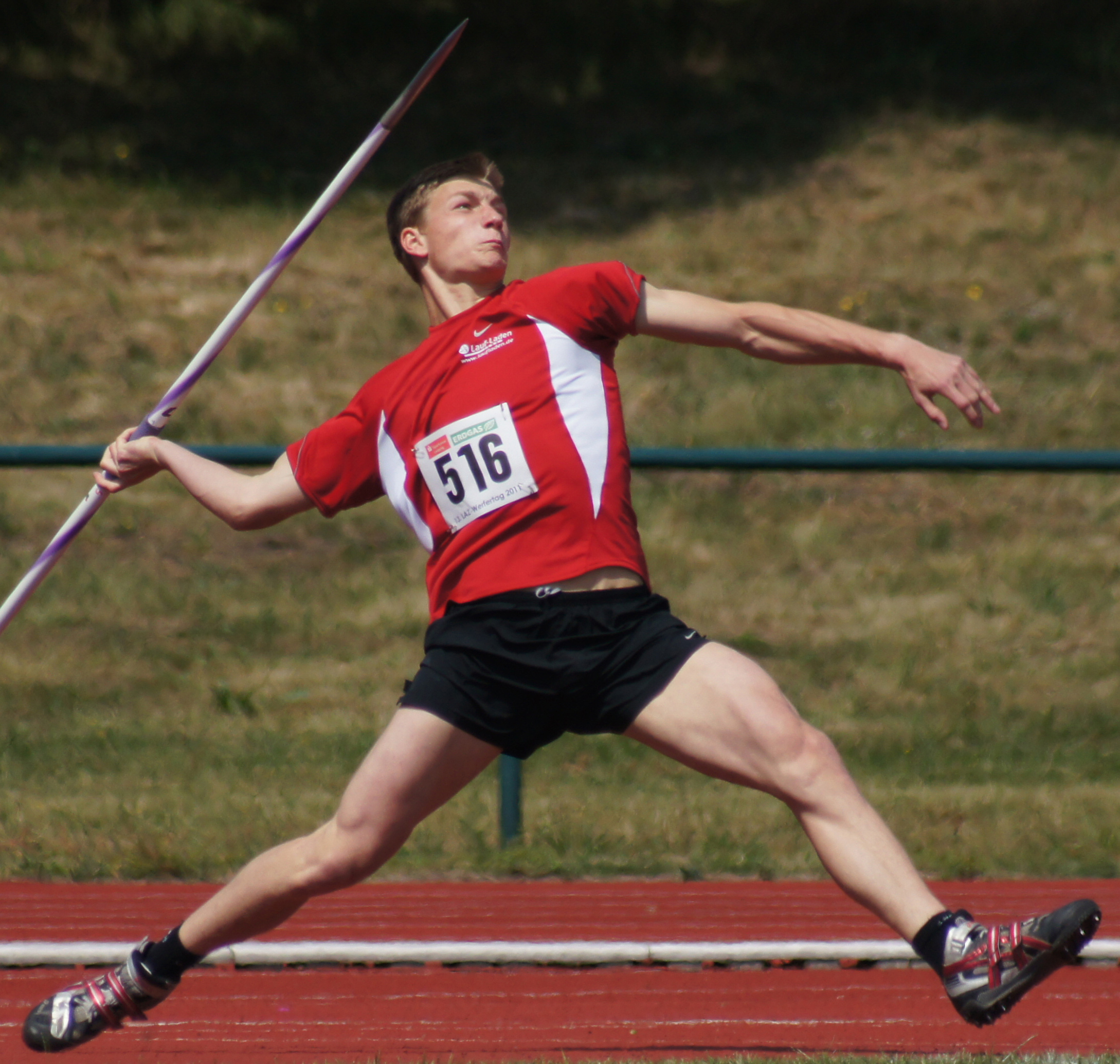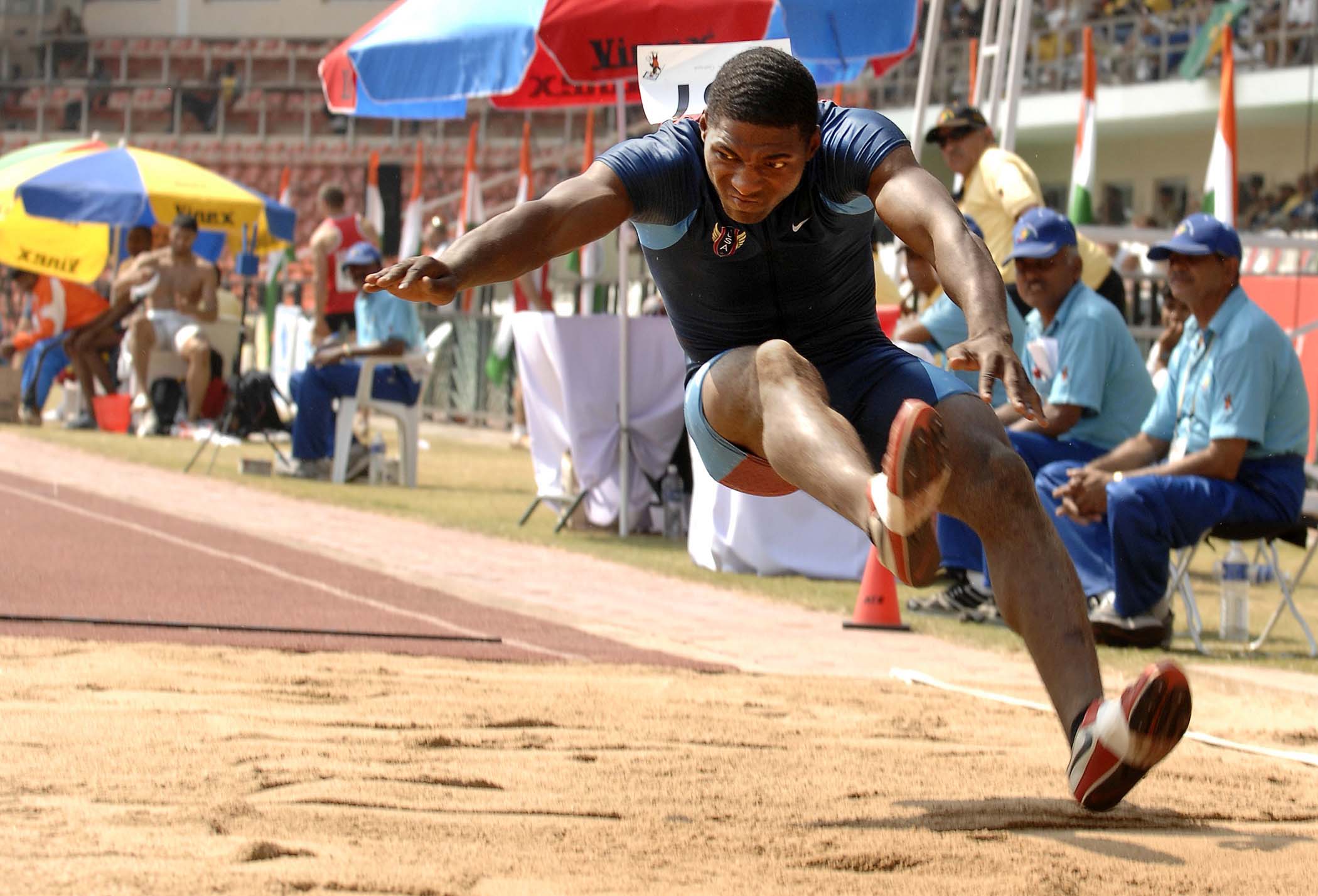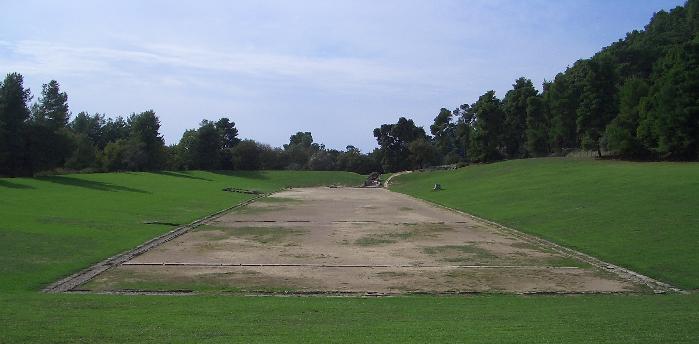|
Modern Pentathlon
The modern pentathlon is an Summer Olympics, Olympic sport consisting of fencing (sport), fencing (one-touch épée), freestyle swimming, show jumping, equestrian show jumping, pistol shooting, and cross country running. The event is inspired by the Ancient Olympic pentathlon, traditional pentathlon held during the ancient Olympics. The modern pentathlon was first held in 1912, and its rules have changed several times over the years. The latest structure, as of the 2020 Summer Olympics, 2020 Olympics, consists of three separate events for fencing, swimming, and equestrian, which determine each athlete's starting time in the final event. The last event, called the laser-run, alternates four legs of laser pistol shooting followed by an 800 m run (for 3200 m in total). The sport has been a feature of the Summer Olympic Games since 1912, despite several attempts to remove it. A world championships for modern pentathlon has been held annually since 1949. The governing body, U ... [...More Info...] [...Related Items...] OR: [Wikipedia] [Google] [Baidu] |
Modern Pentathlon At The 2004 Summer Olympics – Men's
The men's modern pentathlon at the 2004 Summer Olympics took place at the Olympic Modern Pentathlon Centre in Goudi Olympic Complex on 26 August. Thirty-two athletes from 20 nations participated in this event. Although the event was considered wide open, as no other athlete dominated the sport since 2000, the Russians, Lithuanians and Czechs continued to reach the top positions in the men's competition. Russia's Andrey Moiseev won the gold medal with a score of 5,480 points. Andrejus Zadneprovskis of Lithuania won the nation's first ever Olympic medal in modern pentathlon, taking the silver. Libor Capalini of the Czech Republic, on the other hand, claimed the bronze, winning his nation's first medal in the sport since Jan Bártů in 1976. Competition format The modern pentathlon consisted of five events, with all five held in one day. * Shooting: A 4.5 mm air pistol shooting (the athlete must hit 20 shots, one at each target). Score was based on the number of shots ... [...More Info...] [...Related Items...] OR: [Wikipedia] [Google] [Baidu] |
Seed (sports)
A seed is a competitor or team in a sport or other tournament who is given a preliminary ranking for the purposes of the draw. Players/teams are "planted" into the bracket in a manner that is typically intended so that the best do not meet until later in the competition, usually based on regular season. The term was first used in tennis, and is based on the idea of laying out a tournament ladder by arranging slips of paper with the names of players on them the way seeds or seedlings are arranged in a garden: smaller plants up front, larger ones behind. Sometimes the remaining competitors in a single-elimination tournament will be "re-seeded" so that the highest surviving seed is made to play the lowest surviving seed in the next round, the second-highest plays the second-lowest, etc. This may be done after each round, or only at selected intervals. Tennis Professional tennis tournaments seed players based on their rankings. The number of seeds varies from tournament to tourna ... [...More Info...] [...Related Items...] OR: [Wikipedia] [Google] [Baidu] |
Javelin Throw
The javelin throw is a track and field event where the javelin, a spear about in length, is thrown. The javelin thrower gains momentum by running within a predetermined area. Javelin throwing is an event of both the men's decathlon and the women's heptathlon. History The javelin throw was added to the Ancient Olympic Games as part of the pentathlon in 708 BC. It included two events, one for distance and the other for accuracy in hitting a target. The javelin was thrown with the aid of a thong ('' ankyle'' in Greek) that was wound around the middle of the shaft. Athletes held the javelin by the ''ankyle'', and when they released the shaft, the unwinding of the thong gave the javelin a spiral trajectory. Throwing javelin-like poles into targets was revived in Germany and Sweden in the early 1870s. In Sweden, these poles developed into the modern javelin, and throwing them for distance became a common event there and in Finland in the 1880s. The rules continued t ... [...More Info...] [...Related Items...] OR: [Wikipedia] [Google] [Baidu] |
Long Jump
The long jump is a track and field event in which athletes combine speed, strength and agility in an attempt to leap as far as possible from a takeoff point. Along with the triple jump, the two events that measure jumping for distance as a group are referred to as the "horizontal jumps". This event has a history in the ancient Olympic Games and has been a modern Olympic event for men since the first Olympics in 1896 and for women since 1948. Rules At the elite level, competitors run down a runway (usually coated with the same rubberized surface as running tracks, crumb rubber or vulcanized rubber, known generally as an all-weather track) and jump as far as they can from a wooden or synthetic board, 20 centimetres or 8 inches wide, that is built flush with the runway, into a pit filled with soft damp sand. If the competitor starts the leap with any part of the foot past the foul line, the jump is declared a foul and no distance is recorded. A layer of plasticine ... [...More Info...] [...Related Items...] OR: [Wikipedia] [Google] [Baidu] |
Wrestling
Wrestling is a series of combat sports involving grappling-type techniques such as clinch fighting, throws and takedowns, joint locks, pins and other grappling holds. Wrestling techniques have been incorporated into martial arts, combat sports and military systems. The sport can either be genuinely competitive or sportive entertainment (see professional wrestling). Wrestling comes in different forms such as freestyle, Greco-Roman, judo, sambo, folkstyle, catch, submission, sumo, pehlwani, shuai jiao and others. A wrestling bout is a physical competition, between two (sometimes more) competitors or sparring partners, who attempt to gain and maintain a superior position. There are a wide range of styles with varying rules, with both traditional historic and modern styles. The term ''wrestling'' is attested in late Old English, as ''wræstlunge'' (glossing ''palestram''). History Wrestling represents one of the oldest forms of combat. The origins of wrestli ... [...More Info...] [...Related Items...] OR: [Wikipedia] [Google] [Baidu] |
Stadion (running Race)
''Stadion'' or ''stade'' ( grc, στάδιον) was an ancient running event, part of the Ancient Olympic Games and the other Panhellenic Games. It was one of the five major Pentathlon events. It was the premier event of the ''gymnikos agon'' (γυμνικὸς ἀγών "nude competition"). History From the years 776 to 724 BC, the ''stadion'' was the only event that took place at the Olympic Games. The victor gave his name to the entire four-year Olympiad, which has allowed scholars to know the names of nearly every ancient Olympic stadion winner. The ''stadion'' was named after the building in which it took place, also called the ''stadion''. This word became ''stadium'' in Latin, which became the English word stadium A stadium ( : stadiums or stadia) is a place or venue for (mostly) outdoor sports, concerts, or other events and consists of a field or stage either partly or completely surrounded by a tiered structure designed to allow spectators to stand o .... The ... [...More Info...] [...Related Items...] OR: [Wikipedia] [Google] [Baidu] |
Ancient Olympic Games
The ancient Olympic Games (Ὀλυμπιακοὶ ἀγῶνες; la, Olympia, neuter plural: "the Olympics") were a series of athletic competitions among representatives of city-states and were one of the Panhellenic Games of Ancient Greece. They were held in honor of Zeus, and the Greeks gave them a Greek mythology, mythological aition, origin. The originating Olympic Games are traditionally dated to 776 BC. The games were held every four years, or Olympiad, which became a unit of time in historical chronologies. They continued to be celebrated when Greece came under Greece in the Roman era, Roman rule, 2nd century BC. Their last recorded celebration was in AD 393, under the emperor Theodosius I, but archeological evidence indicates that some games were still held after this date.Hamlet, Ingomar. "Theodosius I. And The Olympic Games". Nikephoros 17 (2004): pp. 53-75. The games likely came to an end under Theodosius II, possibly in connection with a fire that burned down the ... [...More Info...] [...Related Items...] OR: [Wikipedia] [Google] [Baidu] |
Viktor Balck
Viktor Gustaf Balck KVO KCMG (25 April 1844 – 31 May 1928) was a Swedish Army officer and sports personality who was one of the original members of the International Olympic Committee, president of the International Skating Union for 30 years, the driving force behind the Nordic Games, and who is often called "the father of Swedish sports". Military career Balck was born in Karlskrona, Sweden, and was a sailor in his youth. In 1861, he joined the Swedish War Academy at Karlberg in Stockholm as an officer cadet of the Swedish Navy. After a while, he switched track to become a cadet for the Swedish Army, and was active in fencing and gymnastics. He stayed on as assistant gymnastics instructor at Karlberg for a while, and in 1866 was commissioned as a second lieutenant in the Närke Regiment. He was promoted to lieutenant in 1875, in the same regiment, and to captain in 1884. [...More Info...] [...Related Items...] OR: [Wikipedia] [Google] [Baidu] |
The New York Times
''The New York Times'' (''the Times'', ''NYT'', or the Gray Lady) is a daily newspaper based in New York City with a worldwide readership reported in 2020 to comprise a declining 840,000 paid print subscribers, and a growing 6 million paid digital subscribers. It also is a producer of popular podcasts such as '' The Daily''. Founded in 1851 by Henry Jarvis Raymond and George Jones, it was initially published by Raymond, Jones & Company. The ''Times'' has won 132 Pulitzer Prizes, the most of any newspaper, and has long been regarded as a national "newspaper of record". For print it is ranked 18th in the world by circulation and 3rd in the U.S. The paper is owned by the New York Times Company, which is publicly traded. It has been governed by the Sulzberger family since 1896, through a dual-class share structure after its shares became publicly traded. A. G. Sulzberger, the paper's publisher and the company's chairman, is the fifth generation of the family to head the p ... [...More Info...] [...Related Items...] OR: [Wikipedia] [Google] [Baidu] |
Olympic Games
The modern Olympic Games or Olympics (french: link=no, Jeux olympiques) are the leading international sporting events featuring summer and winter sports competitions in which thousands of athletes from around the world participate in a multi-sport event, variety of competitions. The Olympic Games are considered the world's foremost sports competition with more than 200 teams, representing sovereign states and territories, participating. The Olympic Games are normally held every Olympiad, four years, and since 1994 Winter Olympics, 1994, have alternated between the Summer Olympic Games, Summer and Winter Olympic Games, Winter Olympics every two years during the four-year period. Their creation was inspired by the ancient Olympic Games (), held in Olympia, Greece from the 8th century BC to the 4th century AD. Pierre de Coubertin, Baron Pierre de Coubertin founded the International Olympic Committee (IOC) in 1894, leading to the first modern Games in Athens in 1896. The IOC is t ... [...More Info...] [...Related Items...] OR: [Wikipedia] [Google] [Baidu] |
Pierre De Coubertin
Charles Pierre de Frédy, Baron de Coubertin (; born Pierre de Frédy; 1 January 1863 – 2 September 1937, also known as Pierre de Coubertin and Baron de Coubertin) was a French educator and historian, founder of the International Olympic Committee, and its second president. He is known as the father of the modern Olympic Games. He was particularly active in promoting the introduction of sport in French schools. Born into a French aristocratic family, he became an academic and studied a broad range of topics, most notably education and history. He graduated with a degree in law and public affairs from the Paris Institute of Political Studies (Sciences Po). It was at Sciences Po that he came up with the idea of reviving the Olympic Games. The Pierre de Coubertin medal (also known as the Coubertin medal o ... [...More Info...] [...Related Items...] OR: [Wikipedia] [Google] [Baidu] |
Interscholastic Equestrian Association
The Interscholastic Equestrian Association (IEA) is a nonprofit organization that gives youth in grades 4-12 the opportunity to compete in team and individual equestrian competition without the financial burden of owning a horse. IEA offers competition across three disciplines: hunt seat, western, and dressage. Within each discipline, there are divisions for beginning through advanced riders. Since all riders compete on horses unfamiliar to them, there are regulations for the placement of riders new to IEA to account for the unique format. IEA was founded in spring of 2002, and has since grown its membership to 14,500 members across 46 states. Teams can be formed through a school or barn. Hunt seat The hunt seat discipline offers both over fences classes and flat classes, judged on the riders equitation. Within hunt seat 11 divisions are offered. High school members can compete in either Varsity Open over fences (fences set at 2'6), Varsity Intermediate over fences (fences set ... [...More Info...] [...Related Items...] OR: [Wikipedia] [Google] [Baidu] |






.png)

